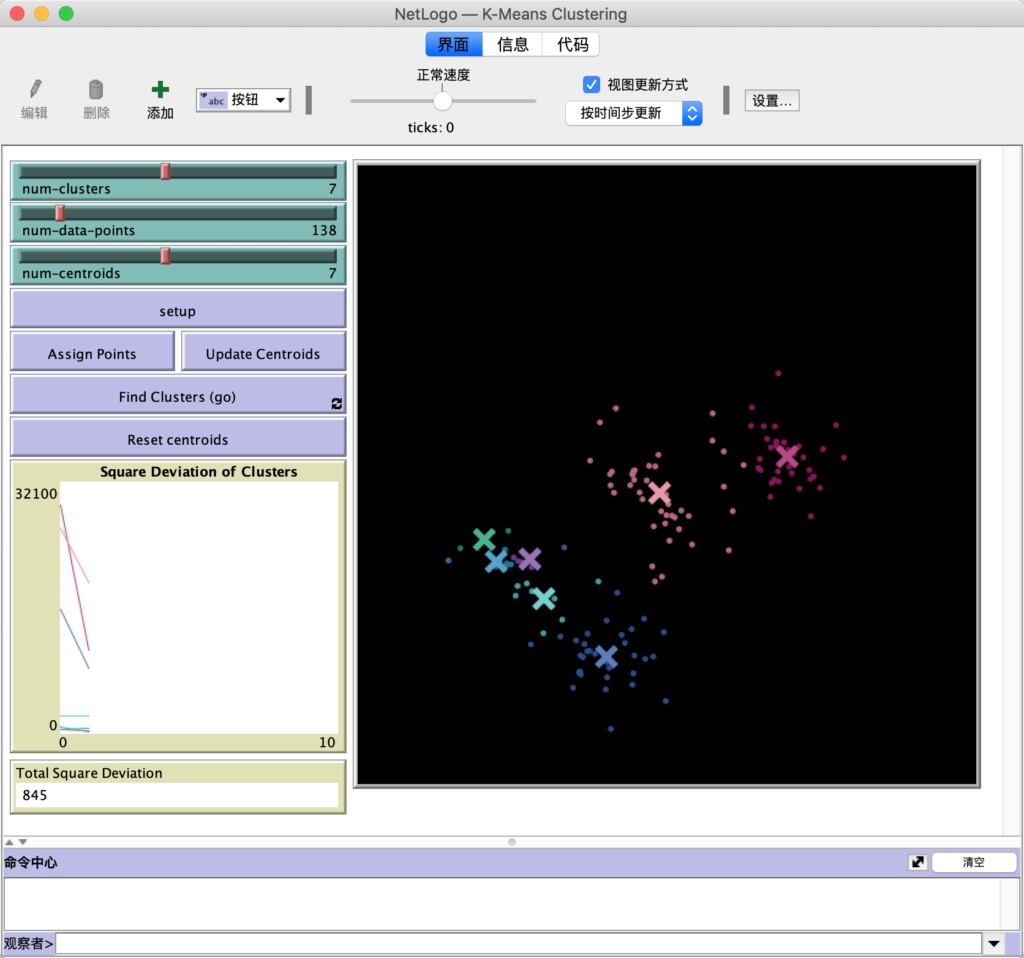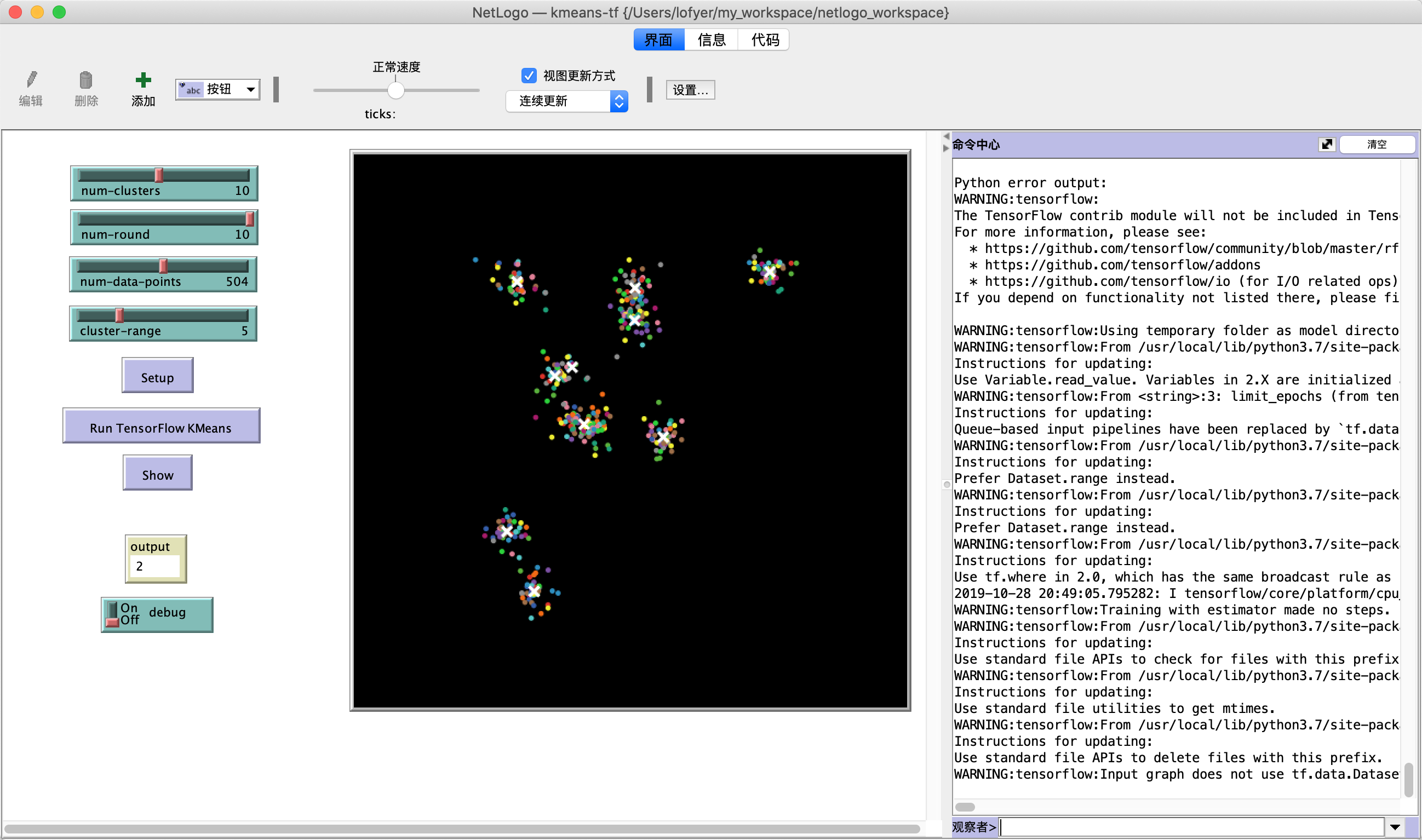Agent based modeling相关
TensorFlow in NetLogo, Make Your Agent More Intelligent
0. Background
NetLogo is a very useful tools for ABM, and Python is also a handful language for building proof of concept.
In this post I will show you how to call python language in NetLogo. For more information please follow here.
1. NetLogo version
1 2 3 4 5 6 7 8 9 10 11 12 13 14 15 16 17 18 19 20 21 22 23 24 25 26 27 28 29 30 31 32 33 34 35 36 37 38 39 40 41 42 43 44 45 46 47 48 49 50 51 52 53 54 55 56 57 58 59 60 61 62 63 64 65 66 67 68 69 70 71 72 73 74 75 76 77 78 79 80 81 82 83 | |
2. TensorFlow version
TensorFlow version: 1.14
1 2 3 4 5 6 7 8 9 10 11 12 13 14 15 16 17 18 19 20 21 22 23 24 25 26 27 28 29 30 31 32 33 | |
3. NetLogo with Python Extension version
Here's the snapshot.
And here's the code.
extensions [ py ]
breed [data-points data-point] breed [centroids centroid]
data-points-own [ cluster-id ]
centroids-own [ cluster-id centx centy ]
globals [ testoutput centroid-list ]
to setup clear-all py:setup py:python (py:run "import tensorflow as tf" "import numpy as np" ) set testoutput py:runresult "1" py:set "testoutput" testoutput set-default-shape data-points "circle" set-default-shape centroids "x" generate-clusters ; For python py:set "num-points" num-clusters py:set "points" [list xcor ycor] of data-points py:set "num-clusters" num-clusters py:set "num-round" num-round if debug = True [ py:run "print('Points Cordinates:', points)" ;for debug ] ;reset-centroids end
to generate-clusters set testoutput py:runresult "testoutput + 1" let cluster-std-dev cluster-range let cluster-size num-data-points / num-clusters repeat num-clusters [ let center-x random-xcor / 1.5 let center-y random-ycor / 1.5 create-data-points cluster-size [ setxy center-x center-y set heading random 360 fd abs random-normal 0 (cluster-std-dev / 2) ] ] end
to train ; Cluster center (py:run "points = np.asarray(points)" "def input-fn():" " return tf.compat.v1.train.limit-epochs(tf.convert-to-tensor(points, dtype=tf.float32), num-epochs=1)" "kmeans = tf.contrib.factorization.KMeansClustering(num-clusters=num-clusters, use-mini-batch=False)" "num-iterations = num-round" "previous-centers = None" "for - in range(num-iterations):" " kmeans.train(input-fn)" " cluster-centers = kmeans.cluster-centers()" " if previous-centers is not None:" " print(('delta:', cluster-centers - previous-centers))" " previous-centers = cluster-centers" " print(('score:', kmeans.score(input-fn)))" "print(('cluster centers:', cluster-centers))" "# map the input points to their clusters" "cluster-indices = list(kmeans.predict-cluster-index(input-fn))" "print('cluster indices: ', cluster-indices)" "for i, point in enumerate(points):" " cluster-index = cluster-indices[i]" " center = cluster-centers[cluster-index]" " print(('point:', point, 'is in cluster', cluster-index, 'centered at', center))" ) end
to show-shape set centroid-list py:runresult "cluster-centers" foreach centroid-list [ x -> create-centroids 1 [ set xcor ( item 0 x ) set ycor ( item 1 x ) set size 3 set color white ] ] end
Ref:
[1] https://www.altoros.com/blog/using-k-means-clustering-in-tensorflow/
[2] https://www.tensorflow.org/api-docs/python/tf/contrib/factorization/KMeansClustering

